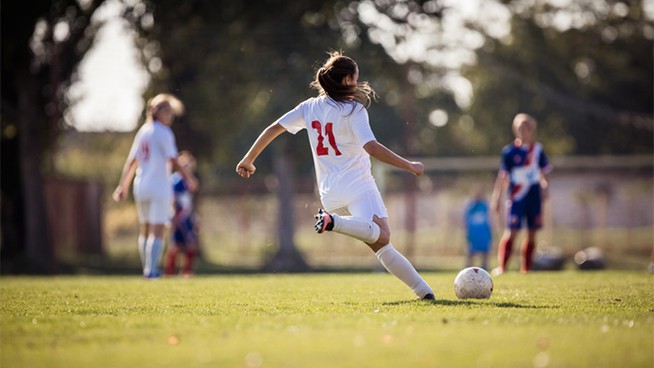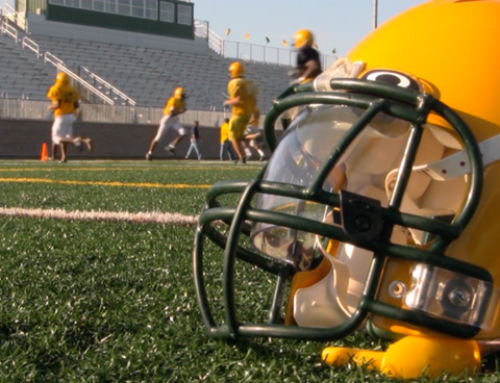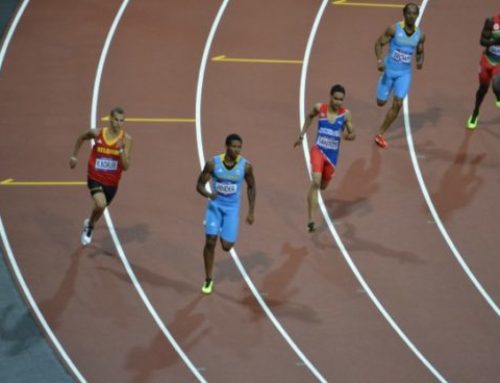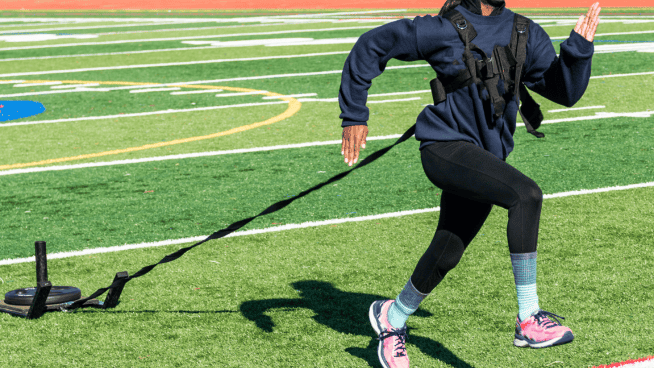Take This Simple Test to Measure Your Speed and Quickness
The 10-Yard Sprint to Deceleration test measures an athlete’s linear acceleration and deceleration. With all the emphasis on the 40-Yard Dash as the go-to for testing an athlete’s speed, we forget that at some point in most sports, athletes must slow down quickly!
The 10-Yard Sprint to Deceleration test emphasizes acceleration and deceleration, giving us the ability to quantify both. The test happens linearly, but this article offers insights into training deceleration in other directions as well.
Instructions
Set up speed gates (or lasers if you have them), preferably a system that beeps when you cross the line, providing external feedback. A stopwatch can be used; however, external feedback such as a beep from the gate promotes more accuracy when measuring reaction time.
Set the gates at 10-yard intervals, since this is a valid measure of an athlete’s raw acceleration. At the 10-yard mark, lay a tape measure out up to 200 inches, or more based on the level of your athletes. When an athlete crosses the line, he must decelerate as quickly as possible in a controlled, athletic position. Measure from the 10-yard mark to the furthest point of the lead foot. This distance becomes the second part of your score in the test.
- For example: 1.8 sec/140 inches.
Using 20 yards would also be effective. We know that elite sprinters and athletes are sometimes still accelerating at 60 yards or more. Novice athletes reach top speed around the 15-30 yard mark, and youth athletes even sooner.
Key Coaching Points:
- Be sure that athletes are accelerating through the 10-yard mark before beginning to decelerate.
- Decelerate in an athletic position. Remember, you are preparing for the next play.
How do you rank?
As with any speed test, you want to know where you stand in relation to others. I have found that athletes who are efficient at decelerating and “absorbing” force are able to decelerate in less than 120 inches; elite athletes are closer to 100 inches. See the rankings below from a largely high school population to see how you stack up.
- Elite: <100 inches
- Varsity: 100-120 inches
- JV: 120-140 inches
- Freshman: 140 inches and over
Why Is Deceleration so Important?
[youtube video=”du5SopfbML0″ /]Apart from track and field, few sports do not require athletes to change direction to be successful. As you saw in the above video, change of direction requires an athlete to go from moving in one direction to rapidly decelerating and then re-accelerating in another direction. Deceleration efficiency is vital to an athlete’s quickness.
Just because you have a fast 40-Yard Dash doesn’t mean you will be a great athlete in competition. You must be able to avoid a defender and create space, like a rabbit escaping a fox. Great athletes are both fast and quick, and you will need both attributes to truly shine.
Football, soccer, basketball, field hockey, volleyball, lacrosse and rugby all require tons of deceleration to be really effective. The restraints of the sidelines create a “stop and go” environment, which athletes are forced to react to. Also, the ability to absorb force during deceleration is important for preventing injuries to the knees, hips and spine. Newton’s third law states that for every action there is an equal and opposite reaction. So, when an athlete changes direction on the football field or lands after jumping for a rebound, a force equal to what he puts into the ground on impact is applied to his center of mass.
How to Improve Deceleration
Training deceleration requires teaching your body how to apply the brakes quickly. If all you do during training is lift weights, you will never reach your potential in terms of true athleticism. A good athlete must be strong to express the qualities of quickness, speed, agility and deceleration. You must do more than just lift heavy weight. To be a great athlete, you must be able to accelerate and decelerate in all planes of movement, both to avoid injury and to perform at the highest level in your sport.
The videos below will give you some ideas about how to add deceleration and quickness exercises to your training.
Landing Mechanics
[youtube video=”86Ag0U1GK4U” /]Isometric Catch Variations for Strength
[youtube video=”haav-w24ZqM” /]Speed Lunges
[youtube video=”2OO6FHJ6Ktw” /]Reaction and Quickness
[youtube video=”frzOxWzGvx4″ /]Banded Change of Direction
Banded Hops and Change of Direction
[youtube video=”mko_PH4x0sM” /]Remember that the most successful training program for any athlete is built on consistency and commitment. You must have a plan and commit yourself to it every day, forever. If you can do this, you will see results.
Find a coach whom you trust and create a plan for success, a plan that will make your weaknesses stronger and your strengths even more polished. Then test where you want to see change and get to work. That was the reason for creating the 10-Yard Sprint to Deceleration test for our athletes at XIP. I wanted to know how good their deceleration or “brakes” were so that I could make better decisions in program design.
Just shopping around YouTube for fancy new exercises each week will not work, and none of the exercises above will make you better if you only do them a few times here or there. You need a system for success, a plan for progression and a drive to dominate every training session you go into. You must have a solid platform of all athletic abilities to be truly great, and then you must hone those skills every day, forever. The journey of an athlete is a marathon not a sprint. Commit yourself for the long haul and you will find greatness.
READ MORE:
[cf]skyword_tracking_tag[/cf]RECOMMENDED FOR YOU
MOST POPULAR
Take This Simple Test to Measure Your Speed and Quickness
The 10-Yard Sprint to Deceleration test measures an athlete’s linear acceleration and deceleration. With all the emphasis on the 40-Yard Dash as the go-to for testing an athlete’s speed, we forget that at some point in most sports, athletes must slow down quickly!
The 10-Yard Sprint to Deceleration test emphasizes acceleration and deceleration, giving us the ability to quantify both. The test happens linearly, but this article offers insights into training deceleration in other directions as well.
Instructions
Set up speed gates (or lasers if you have them), preferably a system that beeps when you cross the line, providing external feedback. A stopwatch can be used; however, external feedback such as a beep from the gate promotes more accuracy when measuring reaction time.
Set the gates at 10-yard intervals, since this is a valid measure of an athlete’s raw acceleration. At the 10-yard mark, lay a tape measure out up to 200 inches, or more based on the level of your athletes. When an athlete crosses the line, he must decelerate as quickly as possible in a controlled, athletic position. Measure from the 10-yard mark to the furthest point of the lead foot. This distance becomes the second part of your score in the test.
- For example: 1.8 sec/140 inches.
Using 20 yards would also be effective. We know that elite sprinters and athletes are sometimes still accelerating at 60 yards or more. Novice athletes reach top speed around the 15-30 yard mark, and youth athletes even sooner.
Key Coaching Points:
- Be sure that athletes are accelerating through the 10-yard mark before beginning to decelerate.
- Decelerate in an athletic position. Remember, you are preparing for the next play.
How do you rank?
As with any speed test, you want to know where you stand in relation to others. I have found that athletes who are efficient at decelerating and “absorbing” force are able to decelerate in less than 120 inches; elite athletes are closer to 100 inches. See the rankings below from a largely high school population to see how you stack up.
- Elite: <100 inches
- Varsity: 100-120 inches
- JV: 120-140 inches
- Freshman: 140 inches and over
Why Is Deceleration so Important?
[youtube video=”du5SopfbML0″ /]Apart from track and field, few sports do not require athletes to change direction to be successful. As you saw in the above video, change of direction requires an athlete to go from moving in one direction to rapidly decelerating and then re-accelerating in another direction. Deceleration efficiency is vital to an athlete’s quickness.
Just because you have a fast 40-Yard Dash doesn’t mean you will be a great athlete in competition. You must be able to avoid a defender and create space, like a rabbit escaping a fox. Great athletes are both fast and quick, and you will need both attributes to truly shine.
Football, soccer, basketball, field hockey, volleyball, lacrosse and rugby all require tons of deceleration to be really effective. The restraints of the sidelines create a “stop and go” environment, which athletes are forced to react to. Also, the ability to absorb force during deceleration is important for preventing injuries to the knees, hips and spine. Newton’s third law states that for every action there is an equal and opposite reaction. So, when an athlete changes direction on the football field or lands after jumping for a rebound, a force equal to what he puts into the ground on impact is applied to his center of mass.
How to Improve Deceleration
Training deceleration requires teaching your body how to apply the brakes quickly. If all you do during training is lift weights, you will never reach your potential in terms of true athleticism. A good athlete must be strong to express the qualities of quickness, speed, agility and deceleration. You must do more than just lift heavy weight. To be a great athlete, you must be able to accelerate and decelerate in all planes of movement, both to avoid injury and to perform at the highest level in your sport.
The videos below will give you some ideas about how to add deceleration and quickness exercises to your training.
Landing Mechanics
[youtube video=”86Ag0U1GK4U” /]Isometric Catch Variations for Strength
[youtube video=”haav-w24ZqM” /]Speed Lunges
[youtube video=”2OO6FHJ6Ktw” /]Reaction and Quickness
Banded Change of Direction
[youtube video=”v6RkAqiEEvM” /]Banded Hops and Change of Direction
[youtube video=”mko_PH4x0sM” /]Remember that the most successful training program for any athlete is built on consistency and commitment. You must have a plan and commit yourself to it every day, forever. If you can do this, you will see results.
Find a coach whom you trust and create a plan for success, a plan that will make your weaknesses stronger and your strengths even more polished. Then test where you want to see change and get to work. That was the reason for creating the 10-Yard Sprint to Deceleration test for our athletes at XIP. I wanted to know how good their deceleration or “brakes” were so that I could make better decisions in program design.
Just shopping around YouTube for fancy new exercises each week will not work, and none of the exercises above will make you better if you only do them a few times here or there. You need a system for success, a plan for progression and a drive to dominate every training session you go into. You must have a solid platform of all athletic abilities to be truly great, and then you must hone those skills every day, forever. The journey of an athlete is a marathon not a sprint. Commit yourself for the long haul and you will find greatness.
READ MORE:
[cf]skyword_tracking_tag[/cf]









